★★
“More Argentinian sword ‘n’ sorcery: mostly harmless.”
 It’s amusing to see that even New Concorde – who released it – don’t seem to have watched the film, their website describing it as “about the legendary lost tribe of warrior women”. Er, no: the A word doesn’t actually get used in the movie, which is really about the quest for a legendary sword, the only thing which stands between an evil sorcerer and world domination.
It’s amusing to see that even New Concorde – who released it – don’t seem to have watched the film, their website describing it as “about the legendary lost tribe of warrior women”. Er, no: the A word doesn’t actually get used in the movie, which is really about the quest for a legendary sword, the only thing which stands between an evil sorcerer and world domination.
There’s something irresistible about a film where it sometimes feels like characters were given names by pulling letters from a Scrabble bag – the sword of Zjiqkl – and for half the movie, we were prepared to swear one villain was called Al Gore. Sadly, it was Balgur. Ah, well, never mind. There’s certainly plenty going on, with plots, treachery, topless human sacrifice, bad blood and an alternate dimension largely realised with dry ice and strobe lights.
The action, unfortunately, sucks, though credit is due to Randolph for struggling with a lethargic snake, making it look like the most ferocious attack in cinematic history. Not sure the animals here were monitored by the American Humane Society either… Less bondage-heavy than the other Argentinian Corman productions, the nudity is still frequent. It’s kinda neat how no-one really makes a fuss about the warriors being female, but this is, at best, a passable waste of 80 minutes.
Dir: Alex Sessa
Star: Windsor Taylor Randolph, Penelope Reed, Joseph Whipp, Danitza Kingsley





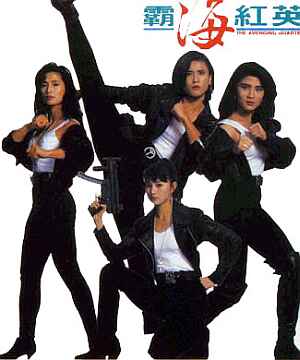 Add supporting roles for Michiko Nishiwaki and Yukari Oshima to Khan and Lee, and you should have a winner, all four being in perhaps the top half-dozen or so action heroines from Hong Kong. Yet while the fights here are grand, the film wastes far too much effort elsewhere. Khan is a Chinese cop who comes to Hong Kong and bumps into gangstress Lee while looking for former lover Waise Lee, who is a) also Lee’s love, and b) now involved with a painting that hides documentation on Japanese wartime human experiments, which Nishiwaki is trying to sell to Oshima. Like I said, far too much effort (if you want to know about those experiments, track down the grim but jaw-dropping Men Behind the Sun).
Add supporting roles for Michiko Nishiwaki and Yukari Oshima to Khan and Lee, and you should have a winner, all four being in perhaps the top half-dozen or so action heroines from Hong Kong. Yet while the fights here are grand, the film wastes far too much effort elsewhere. Khan is a Chinese cop who comes to Hong Kong and bumps into gangstress Lee while looking for former lover Waise Lee, who is a) also Lee’s love, and b) now involved with a painting that hides documentation on Japanese wartime human experiments, which Nishiwaki is trying to sell to Oshima. Like I said, far too much effort (if you want to know about those experiments, track down the grim but jaw-dropping Men Behind the Sun).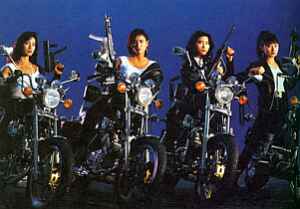 Things do perk up later on; after all the oestrogen, Chin Kar Lok is welcome light relief as an amusing dumb cop, and the finale is excellent, with echoes of Thelma and Louise. However, it’s too little, too late. It’s worth pointing out that while the title and artwork imply some kind of team-up, as in The Heroic Trio, the reality is unfortunately totally different, and nowhere near as interesting.
Things do perk up later on; after all the oestrogen, Chin Kar Lok is welcome light relief as an amusing dumb cop, and the finale is excellent, with echoes of Thelma and Louise. However, it’s too little, too late. It’s worth pointing out that while the title and artwork imply some kind of team-up, as in The Heroic Trio, the reality is unfortunately totally different, and nowhere near as interesting.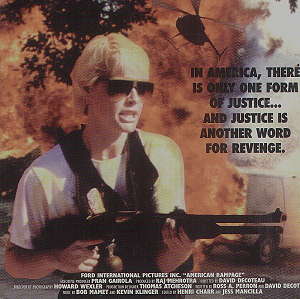 While not averse to the idea of gratuitous nudity in movies, this movie presents some of the most startlingly unattractive examples I’ve seen in some time – but then, director Decoteau is now making (more or less openly) gay-interest movies, so his judgement in such things is highly suspect. Even the heroine, Detective Samantha York, is…well, let’s be kind and say “homely”, though this could count as refreshing realism, given LAPD officers don’t win many beauty contests. I would like to think, however, that they are better shots; York couldn’t hit a barn if she was standing inside it.
While not averse to the idea of gratuitous nudity in movies, this movie presents some of the most startlingly unattractive examples I’ve seen in some time – but then, director Decoteau is now making (more or less openly) gay-interest movies, so his judgement in such things is highly suspect. Even the heroine, Detective Samantha York, is…well, let’s be kind and say “homely”, though this could count as refreshing realism, given LAPD officers don’t win many beauty contests. I would like to think, however, that they are better shots; York couldn’t hit a barn if she was standing inside it.

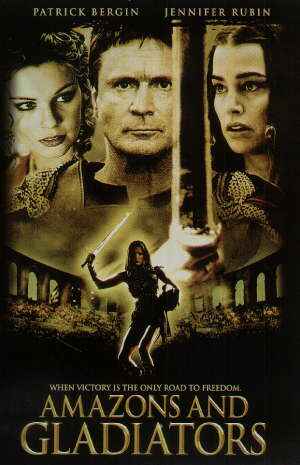 Benefiting from a slew of decent performances, A&G manages to surpass most of the competition and become a worthy entry in the “gladiatrix” sub-genre. This is perhaps because the cast have been hired either because they can act or because they can fight, while simultaneously not embarrassing themselves in the other department. Pity poor Hiltz, who is in virtually every scene, yet doesn’t even get her name on the cover.
Benefiting from a slew of decent performances, A&G manages to surpass most of the competition and become a worthy entry in the “gladiatrix” sub-genre. This is perhaps because the cast have been hired either because they can act or because they can fight, while simultaneously not embarrassing themselves in the other department. Pity poor Hiltz, who is in virtually every scene, yet doesn’t even get her name on the cover. After thirty minutes, I was toying with the idea of giving this the first ever 0 star rating. On that basis, eventually creeping up to two counts as something of a miraculous recovery. The heroine is an alien, transporting her child across the English countryside, while being pursued by white-masked hunters. There is almost no dialogue, which is so obviously a penny-pinching device it hurts – the video stock and woeful “martial arts” don’t help.
After thirty minutes, I was toying with the idea of giving this the first ever 0 star rating. On that basis, eventually creeping up to two counts as something of a miraculous recovery. The heroine is an alien, transporting her child across the English countryside, while being pursued by white-masked hunters. There is almost no dialogue, which is so obviously a penny-pinching device it hurts – the video stock and woeful “martial arts” don’t help.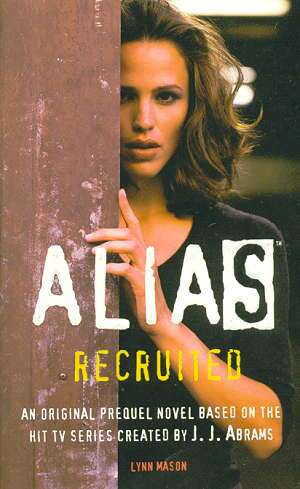 To tide you over the summer until the new series starts, as well as an ‘official companion’, Random House has published two novels, which fill in the back story before the show. Recruited tells of how Sydney Bristow was brought into SD-6, while A Secret Life details her first overseas mission, infiltrating a Paris fashion house being used as a cover for gun-running.
To tide you over the summer until the new series starts, as well as an ‘official companion’, Random House has published two novels, which fill in the back story before the show. Recruited tells of how Sydney Bristow was brought into SD-6, while A Secret Life details her first overseas mission, infiltrating a Paris fashion house being used as a cover for gun-running. Cat opted not to follow in the footsteps of her father, shampoo magnate Vidal, preferring instead to win various karate titles (allegedly) before moving into movies. Between two parts of the Blood Fist series, she popped over to the Philippines, and made this one for Roger Corman, under the gaze of familiar GWG director Santiago (TNT Jackson, etc.). She plays an LA cop, who comes to Manilla to investigate her sister’s death – she was killed after photographing a political assassination. And, hey, whaddya know? She was also taking part in a karate tournament… I trust I need not extend the plot synopsis any further.
Cat opted not to follow in the footsteps of her father, shampoo magnate Vidal, preferring instead to win various karate titles (allegedly) before moving into movies. Between two parts of the Blood Fist series, she popped over to the Philippines, and made this one for Roger Corman, under the gaze of familiar GWG director Santiago (TNT Jackson, etc.). She plays an LA cop, who comes to Manilla to investigate her sister’s death – she was killed after photographing a political assassination. And, hey, whaddya know? She was also taking part in a karate tournament… I trust I need not extend the plot synopsis any further. While this is live-action, Oshii is best known for his anime work, such as Ghost in the Shell. That also had an action heroine, great visual style and lost its way in philosophical navel-gazing. There, it was the nature of self – here, it’s the nature of reality. Set in Poland, which may be a first for a Japanese film, the heroine, Ash (Foremniak), is addicted to an illegal computer game called Avalon. When she hears about the existence of a special level in it, she’ll stop at nothing to find the entrance. But, for her, the line between life and pastime is becoming more and more blurred…
While this is live-action, Oshii is best known for his anime work, such as Ghost in the Shell. That also had an action heroine, great visual style and lost its way in philosophical navel-gazing. There, it was the nature of self – here, it’s the nature of reality. Set in Poland, which may be a first for a Japanese film, the heroine, Ash (Foremniak), is addicted to an illegal computer game called Avalon. When she hears about the existence of a special level in it, she’ll stop at nothing to find the entrance. But, for her, the line between life and pastime is becoming more and more blurred… Don’t look for Aruba Red in your local video store. You won’t find it, because it is a beer. Yes, an alcoholic beverage. So, what in heaven’s name is it doing on this site? Well, as far as I know, it’s the only beer inspired by a female action heroine, albeit a fictitious one.
Don’t look for Aruba Red in your local video store. You won’t find it, because it is a beer. Yes, an alcoholic beverage. So, what in heaven’s name is it doing on this site? Well, as far as I know, it’s the only beer inspired by a female action heroine, albeit a fictitious one.